Ad Sales for Media Cloud Video Series
Q&A Transcript
Join Salesforce’s Principal Solutions Engineer, Stan Shaul, & V2’s Sr. Director of Industries, Joe Hooper, as they discuss media trends & direction, 6 focus areas of media cloud, and how you can use media cloud to maximize your customer value.
Below is the transcript from An Introduction to Media Cloud video interview from our Ad Sales for Media Cloud Series. Please note we have slightly edited this transcript to reduce the length and make it more reader-friendly.
Joe Hooper: Welcome to the next video in the Ad Sales Management series. I’m Joe Hooper, Senior Director of Industry Products and Solutions at V2. I head up our media cloud practice and am very excited today to speak with Stan Shaul. He is a Principal Solutions Engineer at Salesforce and we’re going to be talking a little bit more deeply about media cloud and the value that it offers to media customers. Stan, do you want to give a quick introduction.
Stan Shaul: Sure Stan Shaul, I am based out of Los Angeles but I am a Principal Solutions Engineer on the media cloud team over at Salesforce. I come with many many years in the media industry and just want to talk a little bit about media cloud and what we have to offer.
Joe Hooper: Awesome. So very exciting today, and I understand that you got some presentation that you’re going to take us through today. Let’s get into it.
Stan Shaul: I’m going to introduce you to media cloud. Media cloud really comes back from the verticalization of Salesforce sales cloud and service cloud. It really is what people already know about Salesforce in terms of the underlying CRM. What we’ve done is really look to verticalize that as a solution.
Before I start let me just throw this out. Salesforce is a publicly traded company so we always tell our customers or people that we’re demonstrating to that please take into account. Some of the things that we are talking about are in the future and make sure you use that in terms of making decisions that come into play. Thank you for listening. Hope you find this informative, and let’s go from here.
Stan: Let’s take a look at the entire ecosystem of Salesforce. Now Salesforce itself is originally thought of as a CRM. As it’s progressed over the years, it really is an entire ecosystem that will talk to a customer. Whether that’s a B2B or B2C customer from the marketing side with marketing cloud, to the service side with service cloud, commerce cloud, have analytics come into play, integration to third party systems, platform integration, and Slack as well too.
Where media cloud comes into play is really the strategy to verticalize what exists with Salesforce, as well as work with all those departments. If you think of it in terms of the ability to speak to your customers and take them through guided experiences that are really specific to the media space leveraging all these tools as well as the tools that we have in media cloud.
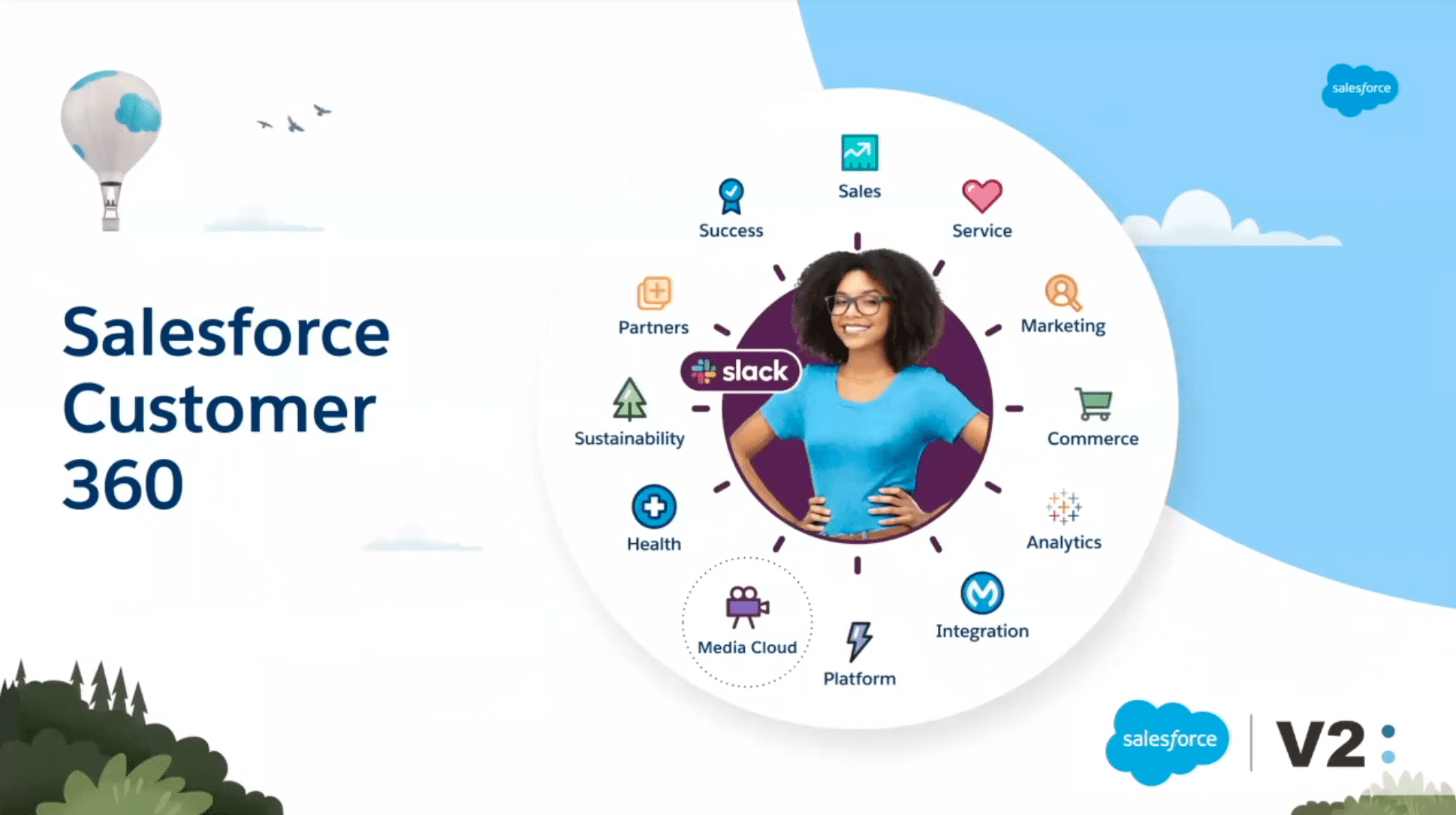
Now what we see in terms of media trends right now are really grouped and organized in terms of these five elements. So right now we find that the customer is at the center of the media business. It’s very transformative right now. We’re seeing a shift of going directly to the consumer.
We’re seeing data and privacy come into play, especially first party data and third party data.
We’re seeing that things are changing from traditional ways of shopping to things like livestream shopping. Really the goal here for most of these media companies is how do I maximize customer lifetime value with all of these different opportunities and changes.
We see the advertising ecosystem coming more into play so that we leverage customers’ eyeballs wherever we have them. And you’re seeing things come into play in terms of how we speak to customers.
Now we have CDP’s where we’re collecting information about a given customer and knowing what they are, what their preferences are, and then trying to figure out better ways to actually speak to that customer. Whether through ads, and targeted options in terms of offers, things like that. We’re converging to an audience first approach. We’re really looking at understanding our audiences and looking to provide personalized experiences, directly to the person, at that given time.
We’re also finding out that automation comes into play especially in media operations, how we do things more efficiently. Data is becoming more and more relevant these days. You see that with these data lakes and houses, and how do we analyze them to make better and smarter decisions.
We see community coming into play especially with things like social media, creator economy, where are you looking at content that used to be primarily first primarily done by studios, now being UTC and user centric. We’re finding global communities and we’re finding the ability for new products to come into play very quickly. Then looking down into the future, we’re looking at things like the Metaverse. These are products that are coming down the road that will be new opportunities for media companies to leverage the content they already have, to the audiences they have and reach new audiences.
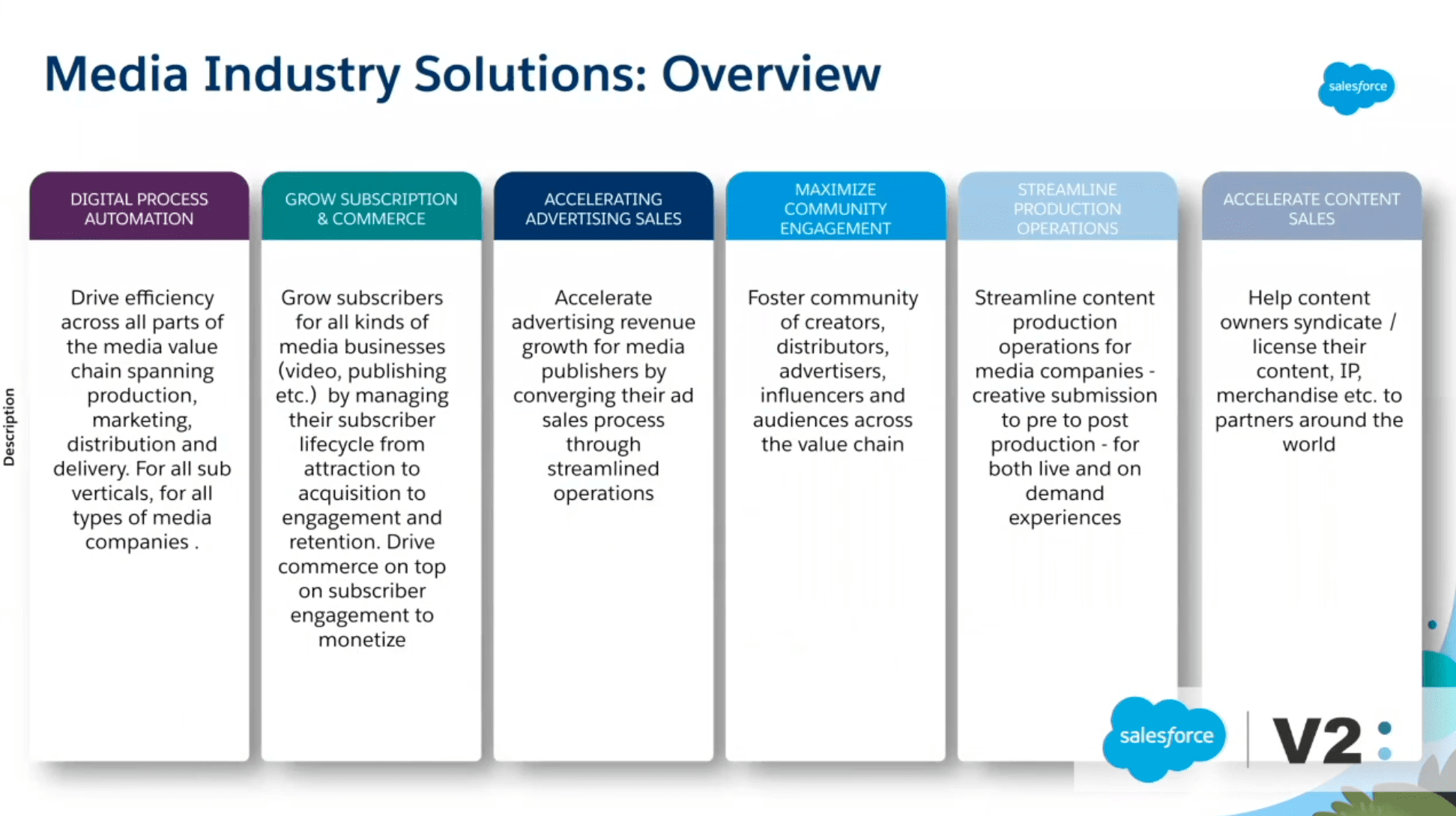
Now in terms of the areas where media cloud is really focused, these are really the 6 areas where we’re putting our energy. The first is digital process automation, or DPA. The idea is to provide a digital tool set that allows you to build experiences on top of the Salesforce platform for B2B and B2C customers. It might be a consumer facing experience, or it might be something that’s directly to maybe a customer service team, or to a B2B operation in the media space.
Secondly, In the subscription space we’re looking at a variety of areas. You see today subscription played a big role especially in the last 2 years with covid coming to play and people really spending their money on subscriptions. It’s a great way to get recurring revenue but again very easy for customers to switch from one place to another. So things like churn management or being able to put the right opportunities in front of the customer at a given time being crucial to both maintaining your existing audience and garnering new customers.
We look at the advertising sales space and we see that revenue is really increasing here especially when you start to maximize revenue from subscribers. How do I go ahead and garner and speak to the eyeballs that we have and optimize our advertising revenue, speak to those audiences, and be forward looking and scalable. So when new products come into play, we have ways to get them out to our teams, to our products, to the content we’re providing, and monetize them as soon as possible.
We look at community engagement too. Whether that’s social media, private communities, or even the traditional communities where people are watching TV and having conversations between each other. Lots of things in terms of engagement there and then how do we speak to those communities as well both as a whole and maybe to individuals through personalization.
Then what that we have, not so much focused on right now, but that comes into play is Studio operations. How do we deal with media companies pre-production to post-production operations and how do we handle that efficiently so that things are streamlined, managed, and everybody can have the right business workflows in there.
And then content sales, people are generating and creating this content. How do you best manage that content, monetize that content, merchandise it, and then sell that to people both domestically and internationally.
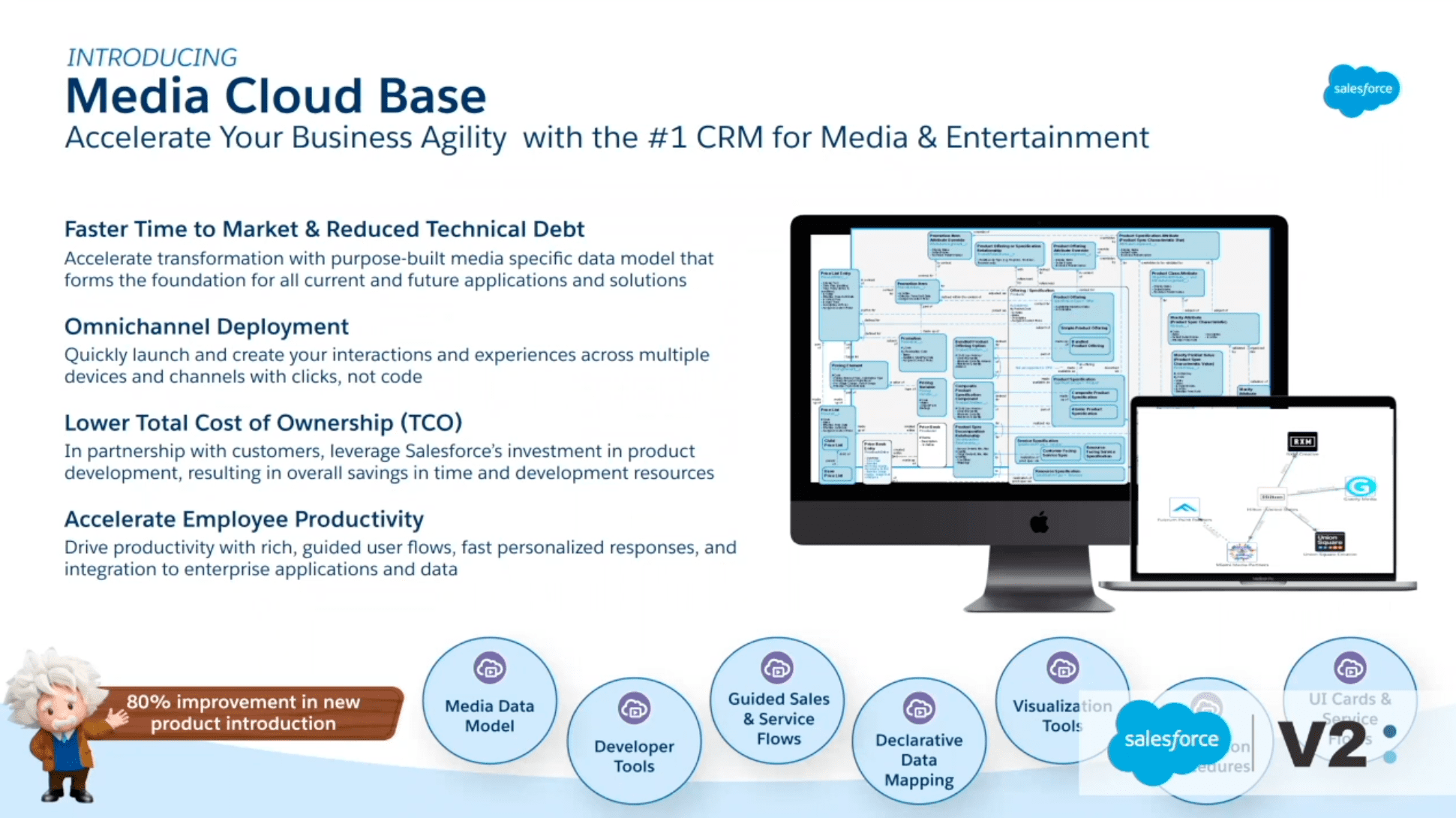
Let’s get into the architecture. The media cloud architecture is really a layered architecture. We’ll go through the layers from the bottom level of the framework all the way up. Let’s start with the base.
The base is a set of data models. These are data models that are built specifically for the media business, subscribers, advertising, and structures that talk to your Salesforce data around those operations. Developer tools to create guided experiences to speak to your Salesforce data, to speak to your data in third party systems like inventory systems or data lakes. Visualization tools to show things like for example relationships between accounts to other accounts and accounts to contacts. A good example might be agency relationships to sub agencies or if you’re in the OTD space, maybe it’s a household and understanding which contacts are in the household and what products do they have – integration procedures to connect to your outgoing systems. And then UI user interface cards, and visual tools to let you easily build experiences either in the Salesforce community itself or in customer facing communities like the Salesforce communities.
Let’s start with a data model. We’ll do just a light overview of that. Really what we’ve done here is taken a look at the kind of operations in the media space. Primarily subscribers in the advertising space on the supply side and the demand side, and built core data structures on top of what comes with the standard Salesforce core data structures. We’ve extended the data structures, the data object to self, and we’ve also created new custom objects that have really been tried and true to the type of the operations that go on. Probably 100 years of man time in building these coming from the team that actually built the data models behind CBUL(10:31) and actually controlled the data models in the Salesforce Environment too. So core to the Salesforce data models, so it’s totally compatible with existing or brownfield systems (10:42) but it will work very seamlessly with new Greenfield and new solutions that are coming out.
Then we also have Omni-studio tools, and they’re a set of tools to optimize and create agile Omni-channel experiences. I’ll start on the left hand side. OmniScript, it’s a declarative tool that lets you build guided experiences, drag-and-drop, to either surface directly to your customers or to your internal team. Great examples might be a support person having a guided flow when someone needs help. Making sure you have guard rails in and taking them through the right steps and asking the right questions. Or you may have something a little more sophisticated like putting together a media plan for a sales plan, where you actually take them through and actually build the media plan itself with the right pricing strategies, discounting strategies. Again easy to modify, easy to deploy, omni-channel, so it can be displayed in multiple environments. FlexCards, which are again drag and drop user interfaces that can be surfaced in your Salesforce community. Great ways to surface your information in a really friendly, customizable look and feel. DataRaptors, it’s a simple ETL tool to speak to your Salesforce data without actually having to write things like SQL code. Just go ahead, a declarative tool, picking the fields that you want and actually having it surface that data and that could be pulling data, pushing data, or manipulating data. Integration procedures, tools to go ahead and speak to outside data via API’s or via other data sources.
And then on the right side are really developer tools to actually go ahead and increase the agility of your development team. Give you insight into what’s going on with your users and tools to go ahead and let you move metadata in and out of your Salesforce environment.
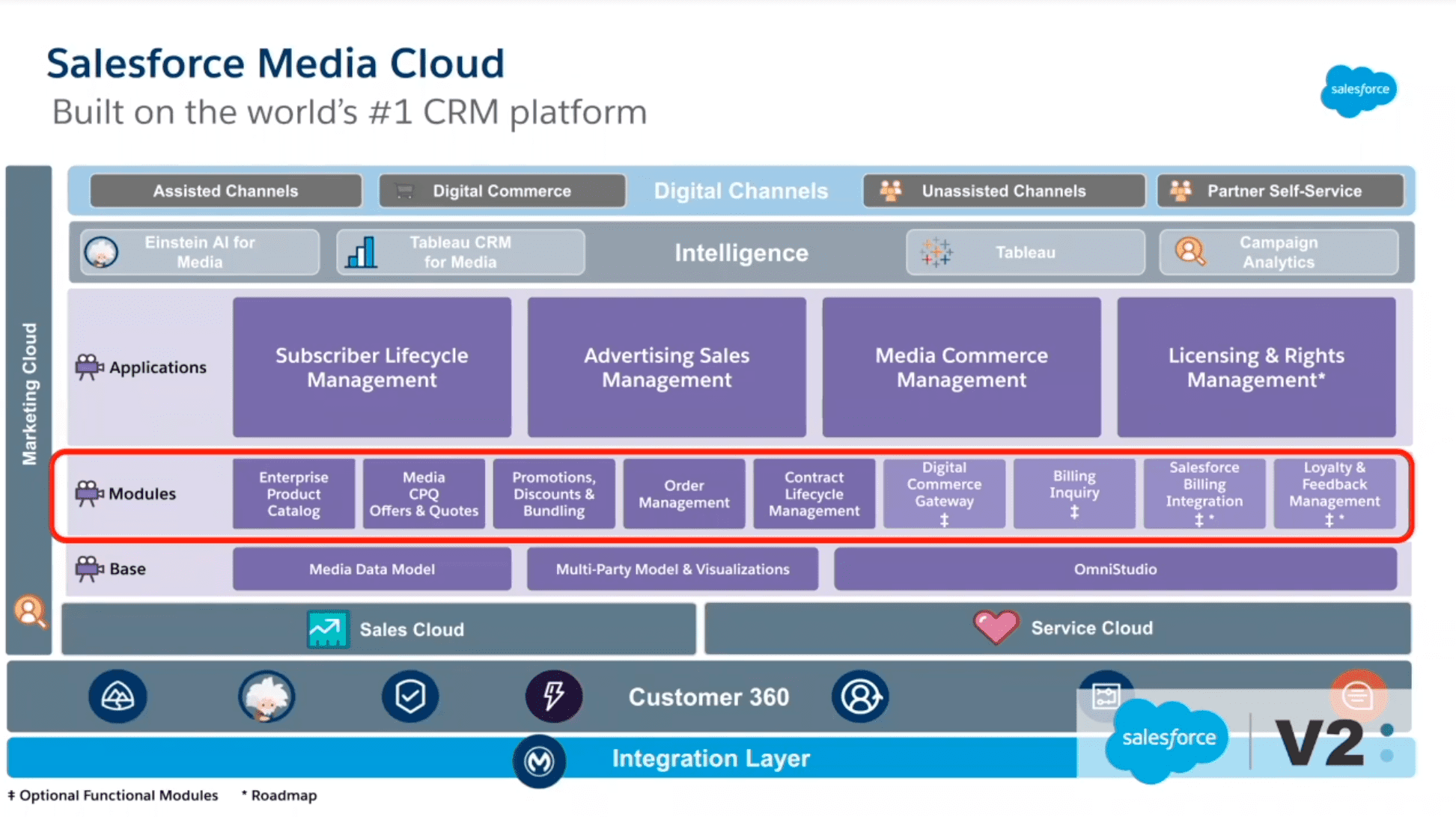
Let’s talk about the four different areas that media cloud really focuses, in terms of fully functional applications that are built on top of the platform. Those are really subscriber lifecycle management and that’s really tools to provide experiences and manage your customers that you subscribe to. That could be a publisher, that could be an OTT environment, could be a retailer. Toolsets to go ahead and manage those experiences and support those experiences.
Advertising Sales Management, and that’s the ability to both handle and build converge media plans. Execute on those plans and that involves everything from actually building the plan, negotiating the plan, quoting it and pricing it out. Taking it to paper with an insertion order and then flighting it and then managing the campaign when it’s in progress and then analytics tools to see how it is performing and to collect the actual data so you know how much money you’re really making.
Media Commerce Management, which is the ability to actually ask for things like credit cards and sell things.
Lastly, licensing and rights management is the ability to actually go ahead and monetize the content and manage the content that you’re marketing.
This is the tech stack that’s involved. Now we’ve talked about the base and the base consists of three elements, the media data model which we discussed.
The multi-party model which is the ability to give you insight into relationships between contacts to contacts, accounts to contacts, and accounts to accounts. You’ve got to think of that as I mentioned before in terms of agencies and how sub agencies are involved and who works for those agencies or things about the household where you have a number of people that might have different accounts. How do you visualize it and know which accounts belong to which particular person and then surface experiences specific to that person. Then OmniStudio which is those tools we talked about, which are essentially tools to help speed up guided flows, access to your data, and surface solutions to your team.
Now the next level is the pitch to play solutions that are around. These are mature products that have been around for about eight years. It consists of everything that takes the experience from the top of the funnel from the time you’ve actually collected an opportunity, to getting people to surface, pay for, and then monetize that opportunity. That consists of enterprise product catalog or EPC. That’s where you define your product. The product might be an ad, in the case of an advertisement sales solution. It might be a movie that you’re playing on an OTT service but the ability to define the product, define the attributes with the product meaning the elements, the sizing, maybe the creative, maybe the elements that need to happen when you actually flight an ad. You know rights around that particular product.
The next thing is the CPQ, or Configured Price Quote Engine. That takes those products and allows you to put a pricing and rules engine around it. Rules about how you can discount, how you can price it. Sophistication like for example in the advertising space it might be rate cards. You might have to go to a programmatic solution, where you’re actually looking at pulling in real time pricing as well too. The ability to build that sophistication into play. The ability to build promotions, discounting, bundling, to actually combine products together in terms of a bundle and then discount and present appropriately.
Next is order management which is what happens when you create an order. How do you service that order, what needs to happen when that order goes into effect. Think of it in terms of you know if I flight a media plan, think of it what needs to happen in terms of the media plan, what needs to go out there to speak to our downstream systems. Do we need to reserve inventory? Do we need to speak to downstream OMS or downstream trafficking system? Do we need to speak to a billing system? That tool provides you the flexibility to both create that, attach that to the order itself, and how to surface it for each individual product or placement in that order.
Contract Lifecycle Management, which is the contractual tool and you can think of it in the advertising space as an insertion order. Creating a particular contract to say this is what the media plan is going to be. But it could be in the B2B space, a way to manage contracts between business, fully versioned, red lining, ability to have electronic document signage as well too.
Next the ancillary products which are digital gateways, the way ability to take money so maybe you’re doing a purchase flow and you want to take money from people. Integrating with your billing system so that when you actually create an order and you actually let your downstream billing system or financial system know how things need to be invoiced and paid for. Lastly integrations to other systems in our ecosystem like loyalty management and feedback if you’ve got to use points to drive behavior as well too.
Moving to on top of that, we have our actual core product itself. Our subscriber lifestyle management, advertising sales management, commerce management, and licensing and rights management. We’ll mainly focus on the first two in terms of our efforts now. These are verticalized products. They are not fully complete because every single customer has their own business processes and own way that they actually manage their business. These can be customized but will get you 80 percent of the way there.
Same for advertising sales as we focus on the supply side. The ability for you to actually work with the particular downstream systems that we have. You may have a particular way you do business, approve financials, approve creative, approve legal and executive oversight, and the negotiation process for doing things for legal. All of those things are things that can be customized but the core ability to create your media plans are out there.
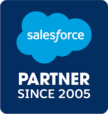
Joe Hooper: Stan Thank you so much for taking us through that. I think this is tremendously valuable for people to understand really what media cloud does and how it’s built under the hood. I’m excited about the continued innovation that we’ll be working with in partnership with Salesforce on around media cloud in 2022 and beyond. So I hope this was informative for all of our viewers and hopefully we can have some conversations about Salesforce and V2 and media solutions and how we can work together. Thanks again Stan.
Stan Shaul: Thanks, appreciate it and look forward to working with you guys as well too.


